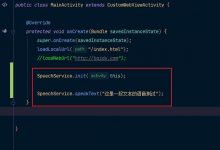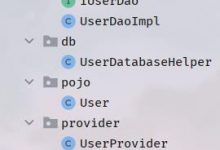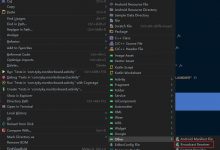概述
postDelay是在android中经常用来处理时延任务的操作。
近期突然比较好奇postDelay实现时延的原理,于是学习后作此文。
如果对handler原理还完全不了解的读者可以看下笔者的此篇文章:Handler源码解析
postDelay的调用过程
public final boolean postDelayed(@NonNull Runnable r, long delayMillis) {return sendMessageDelayed(getPostMessage(r), delayMillis);}
public final boolean sendMessageDelayed(@NonNull Message msg, long delayMillis) {if (delayMillis < 0) {delayMillis = 0;}return sendMessageAtTime(msg, SystemClock.uptimeMillis() + delayMillis);}
public boolean sendMessageAtTime(@NonNull Message msg, long uptimeMillis) {MessageQueue queue = mQueue;if (queue == null) {RuntimeException e = new RuntimeException(this + \" sendMessageAtTime() called with no mQueue\");Log.w(\"Looper\", e.getMessage(), e);return false;}return enqueueMessage(queue, msg, uptimeMillis);}
private boolean enqueueMessage(@NonNull MessageQueue queue, @NonNull Message msg,long uptimeMillis) {msg.target = this;msg.workSourceUid = ThreadLocalWorkSource.getUid();if (mAsynchronous) {msg.setAsynchronous(true);}return queue.enqueueMessage(msg, uptimeMillis);}
MessageQueue.enqueueMessage()
最终可以看到是进入了MessageQueue的enqueueMessage方法中。
enqueueMessage方法中的逻辑如下:
- 针对各种异常情况做处理
- message根据触发时间的从小到大排列。
- 根据mBlocked来判断是否需要触发nativeWake()来唤醒被阻塞的消息队列。
这里通过注释也可以看到。
一般情况下,只有立即触发的消息才会调用到nativeWake(),而时延的消息则不会触发。
boolean enqueueMessage(Message msg, long when) {if (msg.target == null) {throw new IllegalArgumentException(\"Message must have a target.\");}if (msg.isInUse()) {throw new IllegalStateException(msg + \" This message is already in use.\");}synchronized (this) {if (mQuitting) {IllegalStateException e = new IllegalStateException(msg.target + \" sending message to a Handler on a dead thread\");Log.w(TAG, e.getMessage(), e);msg.recycle();return false;}msg.markInUse();msg.when = when;Message p = mMessages;boolean needWake;if (p == null || when == 0 || when < p.when) {// New head, wake up the event queue if blocked.msg.next = p;mMessages = msg;needWake = mBlocked;} else {// Inserted within the middle of the queue. Usually we don\'t have to wake// up the event queue unless there is a barrier at the head of the queue// and the message is the earliest asynchronous message in the queue.needWake = mBlocked && p.target == null && msg.isAsynchronous();Message prev;for (;;) {prev = p;p = p.next;if (p == null || when < p.when) {break;}if (needWake && p.isAsynchronous()) {needWake = false;}}msg.next = p; // invariant: p == prev.nextprev.next = msg;}// We can assume mPtr != 0 because mQuitting is false.if (needWake) {nativeWake(mPtr);}}return true;}
MessageQueue.next()
在了解了looper.loop()的源码之后,我们知道,如果没有消息,那么loop()会阻塞在MessageQueue的next()方法中,接下来我们就需要根据这个关键的方法来进一步解析。
如果不了解looper源码的读者,可以看下笔者开头的文章。
Message next() {// Return here if the message loop has already quit and been disposed.// This can happen if the application tries to restart a looper after quit// which is not supported.final long ptr = mPtr;if (ptr == 0) {return null;}int pendingIdleHandlerCount = -1; // -1 only during first iterationint nextPollTimeoutMillis = 0;for (;;) {if (nextPollTimeoutMillis != 0) {Binder.flushPendingCommands();}nativePollOnce(ptr, nextPollTimeoutMillis);synchronized (this) {// Try to retrieve the next message. Return if found.final long now = SystemClock.uptimeMillis();Message prevMsg = null;Message msg = mMessages;if (msg != null && msg.target == null) {// Stalled by a barrier. Find the next asynchronous message in the queue.do {prevMsg = msg;msg = msg.next;} while (msg != null && !msg.isAsynchronous());}if (msg != null) {if (now < msg.when) {// Next message is not ready. Set a timeout to wake up when it is ready.nextPollTimeoutMillis = (int) Math.min(msg.when - now, Integer.MAX_VALUE);} else {// Got a message.mBlocked = false;if (prevMsg != null) {prevMsg.next = msg.next;} else {mMessages = msg.next;}msg.next = null;if (DEBUG) Log.v(TAG, \"Returning message: \" + msg);msg.markInUse();return msg;}} else {// No more messages.nextPollTimeoutMillis = -1;}// Process the quit message now that all pending messages have been handled.if (mQuitting) {dispose();return null;}// If first time idle, then get the number of idlers to run.// Idle handles only run if the queue is empty or if the first message// in the queue (possibly a barrier) is due to be handled in the future.if (pendingIdleHandlerCount < 0&& (mMessages == null || now < mMessages.when)) {pendingIdleHandlerCount = mIdleHandlers.size();}if (pendingIdleHandlerCount <= 0) {// No idle handlers to run. Loop and wait some more.mBlocked = true;continue;}if (mPendingIdleHandlers == null) {mPendingIdleHandlers = new IdleHandler[Math.max(pendingIdleHandlerCount, 4)];}mPendingIdleHandlers = mIdleHandlers.toArray(mPendingIdleHandlers);}// Run the idle handlers.// We only ever reach this code block during the first iteration.for (int i = 0; i < pendingIdleHandlerCount; i++) {final IdleHandler idler = mPendingIdleHandlers[i];mPendingIdleHandlers[i] = null; // release the reference to the handlerboolean keep = false;try {keep = idler.queueIdle();} catch (Throwable t) {Log.wtf(TAG, \"IdleHandler threw exception\", t);}if (!keep) {synchronized (this) {mIdleHandlers.remove(idler);}}}// Reset the idle handler count to 0 so we do not run them again.pendingIdleHandlerCount = 0;// While calling an idle handler, a new message could have been delivered// so go back and look again for a pending message without waiting.nextPollTimeoutMillis = 0;}}
MessageQueue.IdleHandler
这里发现IdleHandler这个类完全没见过,于是看下它的源码。
/*** Callback interface for discovering when a thread is going to block* waiting for more messages.*/public static interface IdleHandler {/*** Called when the message queue has run out of messages and will now* wait for more. Return true to keep your idle handler active, false* to have it removed. This may be called if there are still messages* pending in the queue, but they are all scheduled to be dispatched* after the current time.*/boolean queueIdle();}
从注释和next()的逻辑中可以看到,在message被阻塞的时候IdleHandler.queueIdle()会被调用到。并且会根据IdleHandler.queueIdle()的返回值来确认是否要从mIdleHandlers的list中移除。
MessageQueue.next()总结
这样整个next()的逻辑就较为清晰了,主要逻辑如下。
- 进来比较关键的点是一个for循环,进入后就会执行执行nativePollOnce方法。如果上一轮的循环中,message是时延执行的,那么这轮循环进入后,会阻阻塞nextPollTimeoutMillis的时间再执行。
- 如果是时延的message,会用nextPollTimeoutMillis记录下下次执行的时间。如果此时已经到了执行message的时间,那么会直接将此message返回。
- 如果此时是时延的message,那么会调用IdleHandler.queueIdle()方法。
 爱站程序员基地
爱站程序员基地


